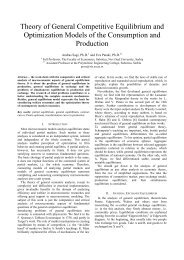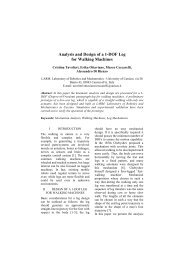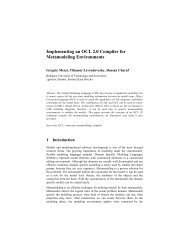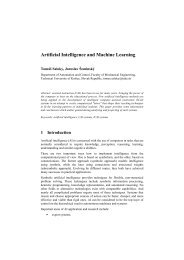generation are hard-pressed to operate at peak efficiencies.While insufficient efficiency of heat energy productionand distribution contributes to overall energy costs,efficiency analysis gains significance and puts into focusthe heart of energy generator - a boiler.The creation of relevant and comprehensiveperformance evidence for regional boiler plantspopulation in the region of the Province of Vojvodinaprovides numerous possibilities for implementing energymanagement approach and for critical evaluation ofaccepted practices in the field of energy efficiency. Acomprehensive insight and added awareness, whichpresented approach enables, in combination with expertand soft computing assistance can locate, recommend andspecify opportunities for increasing energy efficiency ofboiler houses and reduce irrational energy use and relatedcosts.A. Analysis approachSteam and hot water are used throughout industry,commerce and the public sector for a wide range ofprocesses and space heating requirements, and canrepresent significant proportion of the organization’senergy costs. It is, therefore, important for owners andoperators of boilers to ensure that the plant operates asefficient as possible and consequently reduce avoidableenergy costs.All sectors, industrial, commercial and public useefficiency as the basic performance indicator. However,defining, assessing and predicting energy efficiency is noteasy, primarily because it is affected by more factors thananticipated. Therefore, the basic intention of the analysisis to apply neural network approach which can createnecessary preconditions and guidelines for assessing andanticipating boiler operating performance.The approach is designed with a capability foridentifying, investigating and predicting possible influencefactors which should be taken into account for a reliableenergy efficiency analysis. The approach uses neuralnetwork computation which reveals opportunities forefficiency enhancement and makes good insight intoinfluence factors for efficiency.Also, the analysis alerts to the possibility of efficiencydrop in heat energy production, and timely preconditionsfor suggesting effective measures to ensure efficiency ofpower plants.B. Model formulationOperating performance analysis is based oncomputational model which uses data from energy surveysand measurements in the group of randomly selected 65boilers. The audit has been carried out at over 50 sitescovering the representative range of industrial, public andcommercial users of steam and hot water. The samplecovers approximately 25% of all boilers in the Province ofVojvodina which provides reliability and relevance ofobtained results.For this purpose, 65 × 5 experimental measurements arecollected (input parameters). About 300 of those are usedas training data for neural network model and the rest (25)is used for testing.Presented approach develops a model for assessing andpredicting efficiency based on real (measured) operatingperformance. The approach understands the use of neuralnetwork model for analyzing and identifying operationalscenarios which lead to peak efficiencies.The significance of applied method is in providingextensive possibilities for identification of inefficiencies.Proposed approach can be effectively used to assessoperating performance and find optimum operationalregime. The significance is more noticeable in predictingthe response of a complex energy system that cannot beeasily modeled mathematically.C. Auditing methodologyThe first step is selecting necessary parameters for eachsite and particular boiler plant. Chosen relevantinformation and parameters are grouped into boilernameplate information, boiler operational performance,occupation dynamic, capacity engagement, flue gascomposition and state or conditions of the plant and itssubsystems.Techniques used to carry out each audit are: metering,internal monitoring records analysis, engineeringcalculations and specifics based on opinions of operationalstaffs in energy department of each company [3]. Throughmeasurements, direct communications and interviews witha responsible person in the energy department of eachcompany or institution and physical audit of the plant,necessary information is collected and organized inseveral categories in the following way:Common information about the company: Activity;Sector.Common information for selected boiler: Basic /Optional fuel; Boiler type (steam or hot-water boiler);Exploitation time (years); Boiler purpose (technologyor heating); Capacity [t/h] and [MW]; Operationalparameters [oC/bar]; Plant engagement (permanent,seasonal, etc).Boiler operational performance: The most usual loadrange regarding to nominal load capacity [%]; Annualworking hours [h/a]; Specific fuel consumption[m3/h, kg/h].Measurement parameters: Flue gas temperature [oC];Flue gas velocity [m/s]; Load range during themeasuring of flue gas composition [%].Calculated performances: Flue gas flow rate [m³/h];Boiler efficiency according to GCV [%]; Boilerefficiency according to NCV [%]; Flue gas losses[%]; Annual fuel consumption [GWh/a]Combustion quality (flue gas composition): O2 [%] /λ [%]; CO2 [%]; SO2 [ppm]; CO [ppm]; NO [ppm];NOX [ppm] and H2 [ppm]; MCO [kg/h] and MNOX[kg/h].Monitoring and control existence: Stationary andcontinuity oxygen control; Measurement of heatenergy delivery rate; Flow rate measurement of boilerfeed water and condensate return; Combustion qualitycontrol, etc.Control type: Manual; Semiautomatic; Automatic.Reconstruction and/or revitalization record: Burnersand associated equipment; Heat recovery systems(economizer); Pipes; Automatic control equipmentetc.96
D. Overview of existing boiler operating performanceOverview of existing boiler operating performance inthe Province of Vojvodina is carried out for selectedsectors: industry, district heating systems and healthcarefacilities. The main reason for adopting mentioned sectorsarrangement is dominant contribution rate of large andmiddle scale boiler plants of these three sectors in theoverall energy activities in the Province of Vojvodina.Similar, selected type of input fuel is only natural gas andheavy fuel oil, because of dominant sharing rate in fuelstructure. The Fig.1 presents percentage distributionaccording to the sector structure and activity structure forindustrial sector, where companies are structuredaccording to their activities.sugarrefinery11%Industry81%foodindustry46%textileindustry6%truckfarming9%brewing11%HealthcareFacilities12%DistrictHeatingSystems7%tobaccoindustry1%oil refinery5% cementfactorychemical 1%industry1%civil metal worksengineering 8%1%Figure 1. Distribution according to the Sector Structure andActivity Structure for Industrial SectorGenerally, in the Republic of Serbia, occupationdynamics and capacity engagement in energy departmentsare critical obstacles for reaching satisfactory energyefficiency [3]. By establishing reliable patterns forassessing rational use of energy, the energy audit includesinformation about operational character of the plant. Forthis purpose, for all sectors, the following categories areadopted and itemized by occupational intensity:permanent or seasonal operation, operation according toneed, conserved, out of order, cut-off.Similarly, fuel is structured for every sector and it isindicative that the dominant fuel types are natural gas andheavy fuel oil, and then sunflower shell, coal, combinedsunflower shell and coal, light oil in much lowercontribution rate.Key results of measurements and calculations for theboiler population of the sample in the industrial sector,district heating systems and healthcare facilities arepresented in the Table 1, structured by minimum,maximum and average values.For configuration of input values, necessary for neuralnetwork model training, data from dominant categories inoccupational intensity have been used such as: permanentor seasonal operation and operation according to need andfuel types: natural gas and heavy fuel oil.TABLE I.OVERVIEW OF EXISTING BOILER OPERATING PERFORMANCEValueIndustrialSectorDistrictHeating SystemsHealthcareFacilitiesMin Av. Max Min Av. Max Min Av. MaxExploitation[years]3 29 46 20 26 34 2 24 40Capacity[MW]0.4 10.5 81.6 6.8 14.0 23.0 0.5 2.6 6.7Load range[%]15 72 100 50 64 75 40 69 95Oxygen0.61 7.09 18.00 1.70 4.69 9.36 2.21 8.31 18.51content [%]Efficiency[%]60.1 87.8 94.0 85.5 91.3 97.6 61.1 86.0 93.4Flue gastemp. [ o C]115.3 203.3 330.8 49.3 135.1 203.5 136.3 199.1 284.8Operatinghours [h/a]480 4,462 8,664 1,650 3,300 4,500 1,200 4,387 8,650Fuel energy0.57 34.02 376.2 7.51 27.43 51.59 0.44 8.45 30.40[GWh/a]III.NEURAL NETWORK METHODOLOGYThe biggest problem in energy efficiency analysis isrelated to the stochastic nature of influencing factors. Insuch circumstances, adequate approach understands moreaccurately the prediction of energy output by variation ofselected inputs. Neural network methodology enablesreliable prediction which consequently allows planningand carrying out the necessary measures to reachmentioned goals.Classic methods for forecasting include regression andstate space methods. The more modern methods includeexpert systems, fuzzy systems, evolutionaryprogramming, artificial neural networks and variouscombinations of these tools. Among many existing tools,neural networks have received much attention because oftheir clear model, easy implementation and goodperformance. Neural networks have become popular invarious real world applications including prediction andforecasting, function approximation, clustering, speechrecognition and synthesis, pattern recognition andclassification, and many others [8].MATLAB was chosen as the technical computinglanguage for the ANN modeling and the Neural NetworksToolbox as predefined surroundings. A model of theboiler was developed, trained, tested and used in theMATLAB interactive environment, which is highlysuitable for algorithm development, data visualization,data analysis, and simulative calculations.A. Input and output parameters selectionTo learn the network, a set of input-output data isneeded. To learn the network based on known data,matched input and output parameters are used. These datainclude a series of input data that define operationalconditions with the output data that define the efficiencyof energy transformation.Input and output parameters selection is carried out inaccordance with specifics of boilers in a region andidentified inefficiency thorough site surveys andmeasurements.An output parameter is boiler’s efficiency, defined asperformance indicator. Selected input parameters are: typeof fuel, type of boiler, exploitation period, nominalcapacity, load range and oxygen content in flue gases.97
- Page 1 and 2:
4 4 th IEEE International Symposium
- Page 3 and 4:
EXPRES 20124 th International Sympo
- Page 5 and 6:
Application of Thermopile Technolog
- Page 7 and 8:
Design of a Solar Hybrid System....
- Page 9 and 10:
___________________________________
- Page 11 and 12:
environmental protection and global
- Page 13 and 14:
But can we use the human body sweat
- Page 15 and 16:
IX. REFERENCES[1] Todorovic B. Cvje
- Page 17 and 18:
QQ⎛ Λt⎞=⎜⎟⎝ Λ ⎠Nt Nwh
- Page 19 and 20:
Analysis of the Energy-Optimum of H
- Page 21 and 22:
V. OBJECTIVE FUNCTIONThe objective
- Page 23 and 24:
The Set-Up Geometry of Sun Collecto
- Page 25 and 26:
continuous east-west sun collector
- Page 27 and 28:
continuously measure the thermal ch
- Page 29 and 30:
CEvaluation of measurement resultsA
- Page 31 and 32:
Application of Thermopile Technolog
- Page 33 and 34:
Temperature of the components [C]90
- Page 35 and 36:
nighttime, to weather or to the cha
- Page 37 and 38:
η uη u0.50.40.30.20.1T 1 - 400K0.
- Page 39 and 40:
Figure 10. . SPS Concept illustrati
- Page 41 and 42:
[16] Zoya B. Popović: Wireless Pow
- Page 43 and 44:
25.0020.0015.0010.005.000.00Figure
- Page 45 and 46:
· ℃ 0.0738 · 1.209 0.0892
- Page 47 and 48: use may be advantageous not only in
- Page 49 and 50: To find the reasons for this disagr
- Page 51 and 52: Toward Future: Positive Net-Energy
- Page 53 and 54: EnergyPlus environment, we used mod
- Page 55 and 56: To keep future energy consumption d
- Page 57 and 58: A New Calculation Method to Analyse
- Page 59 and 60: On Fig. 3. can be seen the areas th
- Page 61 and 62: Present and Future of Geothermal En
- Page 63 and 64: TABLE II.THE TEMPERATURE DATA AND C
- Page 65 and 66: Error in Water Meter Measuring at W
- Page 67 and 68: III.RESULTS OF MEASURMENTSEach meas
- Page 69 and 70: TABLE I.THE AVERAGE VALUE OF THERMA
- Page 71 and 72: If the walls of the DHEs are made o
- Page 73 and 74: Environmental External Costs Associ
- Page 75 and 76: iodiesel production facility with a
- Page 77 and 78: Contribution of unit processesto ex
- Page 79 and 80: Heat Pump News in HungaryBéla Ád
- Page 81 and 82: Thermal Comfort Measurements In Lar
- Page 83 and 84: IV.DISCUSSIONThe sample frequencies
- Page 85 and 86: For a Clear View of Traditional and
- Page 87 and 88: esults in geographically distribute
- Page 89 and 90: Design of a Solar Hybrid SystemMari
- Page 91 and 92: Maintaining the set point temperatu
- Page 93 and 94: Decision system theory model of ope
- Page 95 and 96: parameter of pump in the function o
- Page 97: Importance and Value of Predictive
- Page 101 and 102: HEAVY FUEL OIL FIRED, STEAMNATURAL
- Page 103 and 104: MATHEMATICAL MODEL AND NUMERICAL SI
- Page 105 and 106: C. Energy balance equationMathemati
- Page 107 and 108: Discretization energy balance equat
- Page 109 and 110: T ulf=32 º C, A - m =0.00162 kg/s,
- Page 111 and 112: Comparison of Heat Pump and MicroCH
- Page 113 and 114: the microCHP development. The energ
- Page 115 and 116: control and stabilizer must be deve
- Page 117 and 118: In Figure 1, in relation to the ord
- Page 119 and 120: NPCC BHXOBYNI x1I x2I x3I x4LO YKYO
- Page 121 and 122: exchange, as in reality, economies
- Page 123 and 124: esponsibilities for consequences, o
- Page 125 and 126: Coca-Cola Enterprise Inc had approx
- Page 127 and 128: Flow Pattern Map for In Tube Evapor
- Page 129 and 130: circumference with a liquid film. T
- Page 131 and 132: Tube diameter: d 6 mm W Heat flux
- Page 133 and 134: Realization of Concurrent Programmi
- Page 135 and 136: applications the development, optim
- Page 137 and 138: Renewable energy sources in automob
- Page 139 and 140: commercial arrays can be built at b
- Page 141 and 142: of multiple thin films produced usi
- Page 143: EXPRES 20124 th International Sympo












